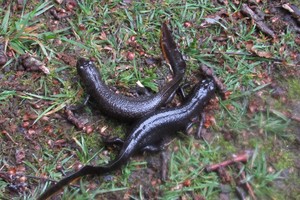New innovative scheme to protect newts and promote sustainable development is rolled out across Yorkshire
Natural England has launched a new scheme in Yorkshire to help conserve local populations of great crested newts while promoting sustainable development

- The scheme helps developers avoid costly delays and uses conservation payments to create new habitats for the protected species
This week an innovative new scheme to protect newts and promote sustainable development has been rolled out across Yorkshire.
Great crested newts have seen dramatic declines in their populations over the last 60 years despite being legally protected. The new ‘District Level Licensing’ scheme better protects this orange-bellied amphibian by using conservation payments from developers to create new ponds in locations that will benefit the species.
The scheme also benefits local people and authorities by avoiding costly delays for developers, helping to ensure homes are built and local authorities can deliver their plans.
The scheme will create a network of ponds across Yorkshire providing vital habitat for our biggest native newt, helping to join up sometimes isolated populations and helping them to thrive.
This week, District Level Licensing for Newts launched across seven local authority areas in North East Yorkshire: Ryedale, Scarborough, York, Selby, North York Moors National Park, Hambleton, and Redcar and Cleveland.
This means the new scheme is now available across Yorkshire and the whole of North East England. Developers in Yorkshire have already expressed interest in joining the scheme.
Craig Thomas, Natural England Natural England’s District Level Licensing Customer Relations Adviser, said:
“District level licensing is transforming a difficult planning process into one that is a real conservation success story.
“The rollout of this scheme in Yorkshire represents a win-win for both local developers and the future of this iconic species. It’s a fantastic example of working in partnership at a landscape scale and bringing improved conservation outcomes for our largest native newt - helping local populations to expand and link up across North East England. What’s more, the approach can also help meet our ambitions to build back greener.”
Alongside local authorities, Natural England is working in partnership with the Yorkshire Wildlife Trust, Wildscapes and Tees Valley Wildlife Trust to create and maintain habitat for great crested newt which would otherwise be threatened by development.
Previously, developers had to apply for a mitigation licence before building on or around the places where newts live. Seasonal restrictions on work in places where the newts were present led to delays and uncertainty over the costs and scheduling of planned development. This new ‘landscape-scale’ licensing approach is better for both developers and newts. It provides a faster and more straightforward process than the traditional approach to licensing while helping to provide more homes for newts.
Thirty seven new ponds have already been created or restored for great crested newts, and together with our partners Natural England are already working on over one hundred more new ponds across Yorkshire. This new habitat will be monitored and looked after by our local, expert partners for 25 years – all funded by the initial payment.
Jeremy Garside, Chief Executive, Tees Valley Wildlife Trust said:
“We’re really pleased to be working with Natural England on this scheme. Our Wildlife Trust is already working with farmers and landowners who are committed to restoring habitats for other protected species such as water vole and barn owl; it is great to have this new opportunity to create newt ponds as well.
“Having witnessed a steady loss of ponds from the landscape over past decades, it is heartening to see this trend reversed and while ponds will be carefully designed to benefit great crested newts, we know that they will be of huge benefit to a much wider range of threatened wildlife species and will help to build networks of habitats which aid nature’s recovery.”
You can apply to join a district level licensing scheme to manage great crested newt populations if you are developing land on .gov.uk at: https://www.gov.uk/government/publications/great-crested-newts-district-level-licensing-schemes.
More about district level licensing in Yorkshire
- Yorkshire is the latest area to launch a district level licensing scheme. This innovative, strategic approach to licensing is now available and being used by developers across 157 local authorities.
- This new licensing approach to authorising development affected by great crested newts is part of a larger programme to reform protected species licensing by focusing conservation effort where it will create maximum benefit. It aims to leave the environment in a better state than before.
- Previously, licences were only granted on a site-by-site basis. This missed opportunities to manage populations of great crested newts on a landscape scale and resulted in habitat for newts being squeezed around development, sometimes in disconnected patches.
- As part of the District Level Licensing project, Natural England has completed the largest ever survey of its type for great crested newts across England, funded by the Ministry of Housing, Communities and Local Government. The data is open and has been published to ArcGIS Online and is available at Data.gov.uk.
- Individual site-by-site mitigation licences are still available; since 17 February 2020, there is now a charge for these licences. In areas where there is a District Level Licensing scheme, joining a scheme will be the quickest option to enable development that affects great crested newts.